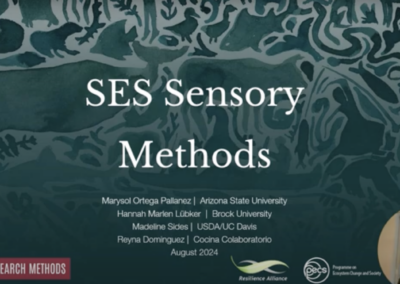Systems scoping is often one of the first steps undertaken in social-ecological systems (SES) research in order to define the boundaries of the research and identify the key relations and dynamics between actors and ecosystems in a given SES. The content on this page discusses social-ecological inventories, stakeholder analysis, historical, social and ecological inventories, cultural domain analysis, contextual profiling, policy scoping and literature reviews as major types of systems scoping methods used in SES research.
The Chapter summary video gives a brief introduction and summary of this group of methods, what SES problems/questions they are useful for, and key resources needed to conduct the methods. The methods video/s introduce specific methods, including their origin and broad purpose, what SES problems/questions the specific method is useful for, examples of the method in use and key resources needed. The Case Studies demonstrate the method in action in more detail, including an introduction to the context and issue, how the method was used, the outcomes of the process and the challenges of implementing the method. The labs/activities give an example of a teaching activity relating to this group of methods, including the objectives of the activity, resources needed, steps to follow and outcomes/evaluation options.
More details can be found in Chapter 5 of the Routledge Handbook of Research Methods for Social-Ecological Systems
Chapter summary:
Sitas, N., Ryan, P. & Schultz, L. (2022)
Method Summaries
Case Studies
Lab teaching/ activity
Tips and Tricks
- Audouin, M., M. Burns, A. Weaver, D. le Maitre, P. O’Farrell, R. du Toit, and J. Nel. 2015. ‘An Introduction to Sustainability Science and its Links to Sustainability Assessment.’ In Handbook of Sustainability Assessment, edited by A. Morrison-Saunders, J. Pope, and A. Bond, 321–346. Cheltenham: Edward Elgar.
- Enfors-Kautsky, E., L. Järnberg, A. Quinlan, and P. Ryan. 2018. Wayfinder: A Resilience Guide for Navigating Towards Sustainable Futures. GRAID Programme, Stockholm Resilience Centre, Stockholm University. https://wayfinder.earth
- Reed, M.S., A. Graves, N. Dandy, H. Posthumus, K. Hubacek, J. Morris, C. Prell, C.H. Quinn, and L.C. Stringer. 2009. ‘Who’s in and Why? A Typology of Stakeholder Analysis Methods for Natural Resource Management.’ Journal of Environmental Management 90(5): 1933–1949.
- Schultz, L., R. Plummer, and S. Purdy. 2011. ‘Applying a Social-Ecological Inventory: A Workbook for Finding Key Actors and Engaging Them.’ www.stockholmresilience.org/publications/publications/2011-06-07-applying-a-social-ecological-inventory-a-workbook-for-finding-key-actors-and-engaging-them.htmlhtml.

